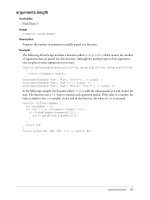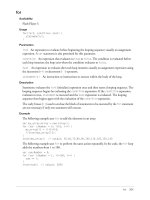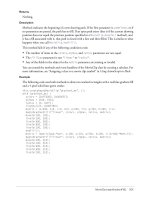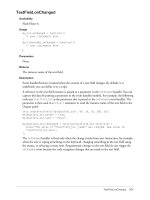Tài liệu Flash: ActionScript Language Reference- P6 docx
Bạn đang xem bản rút gọn của tài liệu. Xem và tải ngay bản đầy đủ của tài liệu tại đây (371.74 KB, 100 trang )
MovieClip.beginGradientFill() 501
Returns
Nothing.
Description
Method; indicates the beginning of a new drawing path. If the first parameter is
undefined,
or if
no parameters are passed, the path has no fill. If an open path exists (that is if the current drawing
position does not equal the previous position specified in a
MovieClip.moveTo()
method), and
it has a fill associated with it, that path is closed with a line and then filled. This is similar to what
happens when you call
MovieClip.endFill()
.
This method fails if any of the following conditions exist:
•
The number of items in the
colors
,
alphas
, and
ratios
parameters are not equal.
•
The
fillType
parameter is not
"linear"
or
"radial"
.
•
Any of the fields in the object for the
matrix
parameter are missing or invalid.
You can extend the methods and event handlers of the MovieClip class by creating a subclass. For
more information, see “Assigning a class to a movie clip symbol” in Using ActionScript in Flash.
Example
The following code uses both methods to draw two stacked rectangles with a red-blue gradient fill
and a 5-pixel solid lime green stroke:
this.createEmptyMovieClip("gradient_mc", 1);
with (gradient_mc) {
colors = [0xFF0000, 0x0000FF];
alphas = [100, 100];
ratios = [0, 0xFF];
lineStyle(5, 0x00ff00);
matrix = {a:500, b:0, c:0, d:0, e:200, f:0, g:350, h:200, i:1};
beginGradientFill("linear", colors, alphas, ratios, matrix);
moveTo(100, 100);
lineTo(100, 300);
lineTo(600, 300);
lineTo(600, 100);
lineTo(100, 100);
endFill();
matrix = {matrixType:"box", x:100, y:310, w:500, h:200, r:(0/180)*Math.PI};
beginGradientFill("linear", colors, alphas, ratios, matrix);
moveTo(100, 310);
lineTo(100, 510);
lineTo(600, 510);
lineTo(600, 310);
lineTo(100, 310);
502 Chapter 2: ActionScript Language Reference
endFill();
}
See also
MovieClip.beginFill(), MovieClip.endFill(), MovieClip.lineStyle(),
MovieClip.lineTo(), MovieClip.moveTo()
MovieClip.clear() 503
MovieClip.clear()
Availability
Flash Player 6.
Usage
my_mc.clear() : Void
Parameters
None.
Returns
Nothing.
Description
Method; removes all the graphics created during runtime using the movie clip draw methods,
including line styles specified with
MovieClip.lineStyle()
. Shapes and lines that are manually
drawn during authoring time (with the Flash drawing tools) are unaffected.
Example
The following example draws a box on the Stage. When the user clicks the box graphic, it removes
the graphic from the Stage.
this.createEmptyMovieClip("box_mc", this.getNextHighestDepth());
box_mc.onRelease = function() {
this.clear();
};
drawBox(box_mc, 10, 10, 320, 240);
function drawBox(mc:MovieClip, x:Number, y:Number, w:Number, h:Number):Void {
mc.lineStyle(0);
mc.beginFill(0xEEEEEE);
mc.moveTo(x, y);
mc.lineTo(x+w, y);
mc.lineTo(x+w, y+h);
mc.lineTo(x, y+h);
mc.lineTo(x, y);
mc.endFill();
}
An example is also in the drawingapi.fla file in the HelpExamples folder. The following list gives
typical paths to this folder:
•
Windows: \Program Files\Macromedia\Flash MX 2004\Samples\HelpExamples\
•
Macintosh: HD/Applications/Macromedia Flash MX 2004/Samples/HelpExamples/
See also
MovieClip.lineStyle()
504 Chapter 2: ActionScript Language Reference
MovieClip.createEmptyMovieClip()
Availability
Flash Player 6.
Usage
my_mc.createEmptyMovieClip(instanceName:String, depth:Number) : MovieClip
Parameters
instanceName
A string that identifies the instance name of the new movie clip.
depth
An integer that specifies the depth of the new movie clip.
Returns
A reference to the newly created movie clip.
Description
Method; creates an empty movie clip as a child of an existing movie clip. This method behaves
similarly to the
attachMovie()
method, but you don’t need to provide an external linkage
identifier for the new movie clip. The registration point for a newly created empty movie clip is
the upper left corner. This method fails if any of the parameters are missing.
You can extend the methods and event handlers of the MovieClip class by creating a subclass. For
more information, see “Assigning a class to a movie clip symbol” in Using ActionScript in Flash.
Example
The following ActionScript creates a new movie clip at runtime and loads a JPEG image into the
movie clip.
this.createEmptyMovieClip("logo_mc", this.getNextHighestDepth());
logo_mc.loadMovie(" />80x92/studio_flashpro.jpg");
See also
MovieClip.attachMovie()
MovieClip.createTextField() 505
MovieClip.createTextField()
Availability
Flash Player 6.
Usage
my_mc.createTextField(instanceName:String,
depth:Number,
x:Number,
y:Number,
width:Number,
height:Number) : Void
Parameters
instanceName
A string that identifies the instance name of the new text field.
depth
A positive integer that specifies the depth of the new text field.
x
An integer that specifies the x coordinate of the new text field.
y
An integer that specifies the y coordinate of the new text field.
width
A positive integer that specifies the width of the new text field.
height
A positive integer that specifies the height of the new text field.
Returns
Nothing.
Description
Method; creates a new, empty text field as a child of the movie clip specified by
my_mc
. You can
use
createTextField()
to create text fields while a SWF file plays. The
depth
parameter
determines the new text field’s z-order position in the movie clip. Each position in the z-order can
contain only one object. If you create a new text field on a depth that already has a text field, the
new text field will replace the existing text field. To avoid overwriting existing text fields, use the
MovieClip.getInstanceAtDepth()
to determine whether a specific depth is already occupied,
or
MovieClip.getNextHighestDepth()
, to determine the highest unoccupied depth. The text
field is positioned at (
x
,
y
) with dimensions
width
by
height
. The
x
and
y
parameters are relative
to the container movie clip; these parameters correspond to the
_x
and
_y
properties of the text
field. The
width
and
height
parameters correspond to the
_width
and
_height
properties of the
text field.
The default properties of a text field are as follows:
type = "dynamic"
border = false
background = false
password = false
multiline = false
html = false
embedFonts = false
selectable = true
wordWrap = false
mouseWheelEnabled = true
condenseWhite = false
restrict = null
506 Chapter 2: ActionScript Language Reference
variable = null
maxChars = null
styleSheet = undefined
tabInded = undefined
A text field created with
createTextField()
receives the following default TextFormat object:
font = "Times New Roman"
size = 12
color = 0x000000
bold = false
italic = false
underline = false
url = ""
target = ""
align = "left"
leftMargin = 0
rightMargin = 0
indent = 0
leading = 0
blockIndent = 0
bullet = false
display = block
tabStops = [] (empty array)
You can extend the methods and event handlers of the MovieClip class by creating a subclass. For
more information, see “Assigning a class to a movie clip symbol” in Using ActionScript in Flash.
Example
The following example creates a text field with a width of 300, a height of 100, an x coordinate of
100, a y coordinate of 100, no border, red, and underlined text:
this.createTextField("my_txt", 1, 100, 100, 300, 100);
my_txt.multiline = true;
my_txt.wordWrap = true;
var my_fmt:TextFormat = new TextFormat();
my_fmt.color = 0xFF0000;
my_fmt.underline = true;
my_txt.text = "This is my first test field object text.";
my_txt.setTextFormat(my_fmt);
An example is also in the animations.fla file in the HelpExamples folder. The following list gives
typical paths to this folder:
•
Windows: \Program Files\Macromedia\Flash MX 2004\HelpExamples\
•
Macintosh: HD/Applications/Macromedia Flash MX 2004/HelpExamples/
See also
TextFormat class
MovieClip._currentframe 507
MovieClip._currentframe
Availability
Flash Player 4.
Usage
my_mc._currentframe:Number
Description
Read-only property; returns the number of the frame in which the playhead is located in the
Timeline specified by
my_mc
.
Example
The following example uses the
_currentframe
property to direct the playhead of the movie clip
actionClip_mc
to advance five frames ahead of its current location:
actionClip_mc.gotoAndStop(actionClip_mc._currentframe + 5);
508 Chapter 2: ActionScript Language Reference
MovieClip.curveTo()
Availability
Flash Player 6.
Usage
my_mc.curveTo(controlX:Number,
controlY:Number,
anchorX:Number, anchorY:Number)
: Void
Parameters
controlX
An integer that specifies the horizontal position of the control point relative to the
registration point of the parent movie clip.
controlY
An integer that specifies the vertical position of the control point relative to the
registration point of the parent movie clip.
anchorX
An integer that specifies the horizontal position of the next anchor point relative to the
registration. point of the parent movie clip.
anchorY
An integer that specifies the vertical position of the next anchor point relative to the
registration point of the parent movie clip.
Returns
Nothing.
Description
Method; draws a curve using the current line style from the current drawing position to
(
anchorX
,
anchorY
) using the control point specified by (
controlX
,
controlY
). The current
drawing position is then set to (
anchorX
,
anchorY
). If the movie clip you are drawing in contains
content created with the Flash drawing tools, calls to
curveTo()
are drawn underneath this
content. If you call
curveTo()
before any calls to
moveTo()
, the current drawing position
defaults to (0, 0). If any of the parameters are missing, this method fails and the current drawing
position is not changed.
You can extend the methods and event handlers of the MovieClip class by creating a subclass. For
more information, see “Assigning a class to a movie clip symbol” in Using ActionScript in Flash.
Example
The following example draws a circle with a solid blue hairline stroke and a solid red fill:
this.createEmptyMovieClip("circle_mc", 1);
with (circle_mc) {
lineStyle(0, 0x0000FF, 100);
beginFill(0xFF0000);
moveTo(500, 500);
curveTo(600, 500, 600, 400);
curveTo(600, 300, 500, 300);
curveTo(400, 300, 400, 400);
curveTo(400, 500, 500, 500);
endFill();
}
MovieClip.curveTo() 509
The curve drawn in this example is a quadratic bezier curve. Quadratic bezier curves consist of
two anchor points and a control point. The curve interpolates the two anchor points, and curves
toward the control point.
The following ActionScript creates a circle using
MovieClip.curveTo()
and the Math class:
this.createEmptyMovieClip("circle2_mc", 2);
circle2_mc.lineStyle(0, 0x000000);
drawCircle(circle2_mc, 10, 10, 100);
function drawCircle(mc:MovieClip, x:Number, y:Number, r:Number):Void {
mc.moveTo(x+r, y);
mc.curveTo(r+x, Math.tan(Math.PI/8)*r+y, Math.sin(Math.PI/4)*r+x,
Math.sin(Math.PI/4)*r+y);
mc.curveTo(Math.tan(Math.PI/8)*r+x, r+y, x, r+y);
mc.curveTo(-Math.tan(Math.PI/8)*r+x, r+y, -Math.sin(Math.PI/4)*r+x,
Math.sin(Math.PI/4)*r+y);
mc.curveTo(-r+x, Math.tan(Math.PI/8)*r+y, -r+x, y);
mc.curveTo(-r+x, -Math.tan(Math.PI/8)*r+y, -Math.sin(Math.PI/4)*r+x, -
Math.sin(Math.PI/4)*r+y);
mc.curveTo(-Math.tan(Math.PI/8)*r+x, -r+y, x, -r+y);
mc.curveTo(Math.tan(Math.PI/8)*r+x, -r+y, Math.sin(Math.PI/4)*r+x, -
Math.sin(Math.PI/4)*r+y);
mc.curveTo(r+x, -Math.tan(Math.PI/8)*r+y, r+x, y);
}
An example is also in the drawingapi.fla file in the HelpExamples folder. The following list gives
typical paths to this folder:
•
Windows: \Program Files\Macromedia\Flash MX 2004\Samples\HelpExamples\
•
Macintosh: HD/Applications/Macromedia Flash MX 2004/Samples/HelpExamples/
See also
MovieClip.beginFill(), MovieClip.createEmptyMovieClip(), MovieClip.endFill(),
MovieClip.lineStyle(), MovieClip.lineTo(), MovieClip.moveTo()
510 Chapter 2: ActionScript Language Reference
MovieClip._droptarget
Availability
Flash Player 4.
Usage
my_mc._droptarget:String
Description
Read-only property; returns the absolute path in slash syntax notation of the movie clip instance
on which
my_mc
was dropped. The
_droptarget
property always returns a path that starts with a
slash (
/
). To compare the
_droptarget
property of an instance to a reference, use the
eval()
function to convert the returned value from slash syntax to a dot syntax reference.
Note: You must perform this conversion if you are using ActionScript 2.0, which does not support
slash syntax.
Example
The following example evaluates the
_droptarget
property of the
garbage_mc
movie clip
instance and uses
eval()
to convert it from slash syntax to a dot syntax reference. The
garbage_mc
reference is then compared to the reference to the
trashcan_mc
movie clip instance.
If the two references are equivalent, the visibility of
garbage_mc
is set to
false
. If they are not
equivalent, the
garbage
instance resets to its original position.
origX = garbage_mc._x;
origY = garbage_mc._y;
garbage_mc.onPress = function() {
this.startDrag();
};
garbage_mc.onRelease = function() {
this.stopDrag();
if (eval(this._droptarget) == trashcan_mc) {
this._visible = false;
} else {
this._x = origX;
this._y = origY;
}
};
See also
startDrag(), stopDrag()
MovieClip.duplicateMovieClip() 511
MovieClip.duplicateMovieClip()
Availability
Flash Player 5.
Usage
my_mc.duplicateMovieClip(newname:String, depth:Number [,initObject:Object]) :
MovieClip
Parameters
newname
A unique identifier for the duplicate movie clip.
depth
A unique number specifying the depth at which the SWF file specified is to be placed.
initObject
(Supported for Flash Player 6 and later.) An object containing properties with
which to populate the duplicated movie clip. This parameter allows dynamically created movie
clips to receive clip parameters. If
initObject
is not an object, it is ignored. All properties of
initObject
are copied into the new instance. The properties specified with
initObject
are
available to the constructor function. This parameter is optional.
Returns
A reference to the duplicated movie clip.
Description
Method; creates an instance of the specified movie clip while the SWF file is playing. Duplicated
movie clips always start playing at Frame 1, no matter what frame the original movie clip is on
when the
duplicateMovieClip()
method is called. Variables in the parent movie clip are not
copied into the duplicate movie clip. Movie clips that have been created using
duplicateMovieClip()
are not duplicated if you call
duplicateMovieClip()
on their parent.
If the parent movie clip is deleted, the duplicate movie clip is also deleted. If you have loaded a
movie clip using
MovieClip.loadMovie()
or the MovieClipLoader class, the contents of the
SWF file are not duplicated. This means that you cannot save bandwidth by loading a JPEG or
SWF file and then duplicating the movie clip.
Example
The following example duplicates the
circle_mc
movie clip. The code creates the movie clip,
called
circle1_mc
, at the x, y coordinates 20,20.
circle_mc.duplicateMovieClip("circle1_mc", this.getNextHighestDepth(), {_x:20,
_y:20});
See also
duplicateMovieClip(), MovieClip.removeMovieClip()
512 Chapter 2: ActionScript Language Reference
MovieClip.enabled
Availability
Flash Player 6.
Usage
my_mc.enabled:Boolean
Description
Property; a Boolean value that indicates whether a movie clip is enabled. The default value of
enabled
is
true
. If
enabled
is set to
false
, the movie clip’s callback methods and
on
action
event handlers are no longer invoked, and the Over, Down, and Up frames are disabled. The
enabled
property does not affect the Timeline of the movie clip; if a movie clip is playing, it
continues to play. The movie clip continues to receive movie clip events (for example,
mouseDown
,
mouseUp
,
keyDown
, and
keyUp
).
The
enabled
property only governs the button-like properties of a movie clip. You can change
the
enabled
property at any time; the modified movie clip is immediately enabled or disabled.
The
enabled
property can be read out of a prototype object. If
enabled
is set to
false
, the
object is not included in automatic tab ordering.
Example
The following example disables the
circle_mc
movie clip when the user clicks it.
circle_mc.onRelease = function() {
trace("disabling the "+this._name+" movie clip.");
this.enabled = false;
};
MovieClip.endFill() 513
MovieClip.endFill()
Availability
Flash Player 6.
Usage
my_mc.endFill() : Void
Parameters
None.
Returns
Nothing.
Description
Method; applies a fill to the lines and curves added since the last call to
beginFill()
or
beginGradientFill()
. Flash uses the fill that was specified in the previous call to
beginFill()
or
beginGradientFill()
. If the current drawing position does not equal the previous position
specified in a
moveTo()
method and a fill is defined, the path is closed with a line and then filled.
Example
The following example creates a square with red fill on the Stage.
this.createEmptyMovieClip("square_mc", this.getNextHighestDepth());
square_mc.beginFill(0xFF0000);
square_mc.moveTo(10, 10);
square_mc.lineTo(100, 10);
square_mc.lineTo(100, 100);
square_mc.lineTo(10, 100);
square_mc.lineTo(10, 10);
square_mc.endFill();
An example is also in the drawingapi.fla file in the HelpExamples folder. The following list gives
typical paths to this folder:
•
Windows: \Program Files\Macromedia\Flash MX 2004\Samples\HelpExamples\
•
Macintosh: HD/Applications/Macromedia Flash MX 2004/Samples/HelpExamples/
See Also
MovieClip.beginFill(), MovieClip.beginGradientFill(), MovieClip.moveTo()
514 Chapter 2: ActionScript Language Reference
MovieClip.focusEnabled
Availability
Flash Player 6.
Usage
my_mc.focusEnabled:Boolean
Description
Property; if the value is
undefined
or
false
, a movie clip cannot receive input focus unless it is a
button. If the
focusEnabled
property value is
true
, a movie clip can receive input focus even if it
is not a button.
Example
The following example sets the
focusEnabled
property for the movie clip
my_mc
to
false
:
my_mc.focusEnabled = false;
MovieClip._focusrect 515
MovieClip._focusrect
Availability
Flash Player 6.
Usage
my_mc._focusrect:Boolean
Description
Property; a Boolean value that specifies whether a movie clip has a yellow rectangle around it
when it has keyboard focus. This property can override the global
_focusrect
property. The
default value of the
_focusrect
property of a movie clip instance is
null
; meaning, the movie
clip instance does not override the global
_focusrect
property. If the
_focusrect
of a movie
clip instance is set to
true
or
false
, it overrides the setting of the global
_focusrect
property
for the single movie clip instance.
In Flash Player 4 or Flash Player 5 SWF files, the
_focusrect
property controls the global
_focusrect
property. It is a Boolean value. This behavior was changed in Flash Player 6 and later
to permit the customization of
_focusrect
on an individual movie clip basis.
Example
This example demonstrates how to hide the yellow rectangle around a specified movie clip
instance in a SWF file when it has focus in a browser window. Create three movie clips called
mc1_mc
,
mc2_mc
, and
mc3_mc
, and add the following ActionScript in Frame 1 of the Timeline:
mc1_mc._focusrect = true;
mc2_mc._focusrect = false;
mc3_mc._focusrect = true;
mc1_mc.onRelease = traceOnRelease;
mc3_mc.onRelease = traceOnRelease;
function traceOnRelease() {
trace(this._name);
}
Test the SWF file in a browser window by selecting File > Publish Preview > HTML. Give the
SWF focus by clicking it in the browser window, and press Tab to focus each instance. You will
not be able to execute code for this movie clip in the browser by pressing Enter or the Spacebar
when
_focusrect
is disabled.
Additionally, you can test your SWF file in the test environment. Select Control > Disable
Keyboard Shortcuts from the main menu in the test environment. This allows you to view the
focus rectangle around the instances in the SWF file.
See Also
Button._focusrect, _focusrect
516 Chapter 2: ActionScript Language Reference
MovieClip._framesloaded
Availability
Flash Player 4.
Usage
my_mc._framesloaded:Number
Description
Read-only property; the number of frames that have been loaded from a streaming SWF file. This
property is useful for determining whether the contents of a specific frame, and all the frames
before it, have loaded and are available locally in the browser. It is also useful for monitoring the
downloading of large SWF files. For example, you might want to display a message to users
indicating that the SWF file is loading until a specified frame in the SWF file has finished
loading.
Example
The following example uses the
_framesloaded
property to start a SWF file when all the frames
are loaded. If all the frames aren’t loaded, the
_xscale
property of the movie clip instance
loader
is increased proportionally to create a progress bar.
Enter the following ActionScript in Frame 1 of the Timeline:
var pctLoaded:Number = Math.round(this.getBytesLoaded()/
this.getBytesTotal()*100);
bar_mc._xscale = pctLoaded;
Add the following code to Frame 2:
if (this._framesloaded<this._totalframes) {
this.gotoAndPlay(1);
} else {
this.gotoAndStop(3);
}
Place your content on or after Frame 3. Then add the following code to Frame 3:
stop();
See also
MovieClipLoader class
MovieClip.getBounds() 517
MovieClip.getBounds()
Availability
Flash Player 5.
Usage
my_mc.getBounds(targetCoordinateSpace:Object) : Object
Parameters
targetCoordinateSpace
The target path of the Timeline whose coordinate system you want
to use as a reference point.
Returns
An object with the properties
xMin
,
xMax
,
yMin
, and
yMax.
Description
Method; returns properties that are the minimum and maximum x and y coordinate values of the
instance specified by
my_mc
for the
targetCoordinateSpace
parameter.
Note: Use
MovieClip.localToGlobal()
and
MovieClip.globalToLocal()
to convert the movie clip’s
local coordinates to Stage coordinates, or Stage coordinates to local coordinates, respectively.
You can extend the methods and event handlers of the MovieClip class by creating a subclass. For
more information, see “Assigning a class to a movie clip symbol” in Using ActionScript in Flash.
Example
The following example creates a movie clip called
square_mc
. The code draws a square for that
movie clip and uses
MovieClip.getBounds()
to display the coordinate values of the instance in
the Output panel.
this.createEmptyMovieClip("square_mc", 1);
square_mc._x = 10;
square_mc._y = 10;
square_mc.beginFill(0xFF0000);
square_mc.moveTo(0, 0);
square_mc.lineTo(100, 0);
square_mc.lineTo(100, 100);
square_mc.lineTo(0, 100);
square_mc.lineTo(0, 0);
square_mc.endFill();
var bounds_obj:Object = square_mc.getBounds(this);
for (var i in bounds_obj) {
trace(i+" --> "+bounds_obj[i]);
}
The following information displays in the Output panel:
yMax --> 110
yMin --> 10
xMax --> 110
xMin --> 10
518 Chapter 2: ActionScript Language Reference
See also
MovieClip.globalToLocal(), MovieClip.localToGlobal()
MovieClip.getBytesLoaded() 519
MovieClip.getBytesLoaded()
Availability
Flash Player 5.
Usage
my_mc.getBytesLoaded() : Number
Parameters
None.
Returns
An integer indicating the number of bytes loaded.
Description
Method; returns the number of bytes that have already loaded (streamed) for the movie clip
specified by
my_mc
. You can compare this value with the value returned by
MovieClip.getBytesTotal()
to determine what percentage of a movie clip has loaded.
You can extend the methods and event handlers of the MovieClip class by creating a subclass. For
more information, see “Assigning a class to a movie clip symbol” in Using ActionScript in Flash.
Example
The following example uses the
_framesloaded
property to start a SWF file when all the frames
are loaded. If all the frames aren’t loaded, the
_xscale
property of the movie clip instance
loader
is increased proportionally to create a progress bar.
Enter the following ActionScript in Frame 1 of the Timeline:
var pctLoaded:Number = Math.round(this.getBytesLoaded()/
this.getBytesTotal()*100);
bar_mc._xscale = pctLoaded;
Add the following code to Frame 2:
if (this._framesloaded<this._totalframes) {
this.gotoAndPlay(1);
} else {
this.gotoAndStop(3);
}
Place your content on or after Frame 3. Then add the following code to Frame 3:
stop();
See also
MovieClip.getBytesTotal()
520 Chapter 2: ActionScript Language Reference
MovieClip.getBytesTotal()
Availability
Flash Player 5.
Usage
my_mc.getBytesTotal() : Number
Parameters
None.
Returns
An integer indicating the total size, in bytes, of
my_mc
.
Description
Method; returns the size, in bytes, of the movie clip specified by
my_mc
. For movie clips that are
external (the root SWF file or a movie clip that is being loaded into a target or a level), the return
value is the size of the SWF file.
You can extend the methods and event handlers of the MovieClip class by creating a subclass. For
more information, see “Assigning a class to a movie clip symbol” in Using ActionScript in Flash.
Example
The following example uses the
_framesloaded
property to start a SWF file when all the frames
are loaded. If all the frames aren’t loaded, the
_xscale
property of the movie clip instance
loader
is increased proportionally to create a progress bar.
Enter the following ActionScript in Frame 1 of the Timeline:
var pctLoaded:Number = Math.round(this.getBytesLoaded()/
this.getBytesTotal()*100);
bar_mc._xscale = pctLoaded;
Add the following code to Frame 2:
if (this._framesloaded<this._totalframes) {
this.gotoAndPlay(1);
} else {
this.gotoAndStop(3);
}
Place your content on or after Frame 3. Then add the following code to Frame 3:
stop();
See also
MovieClip.getBytesLoaded()
MovieClip.getDepth() 521
MovieClip.getDepth()
Availability
Flash Player 6.
Usage
my_mc.getDepth() : Number
Parameters
None.
Returns
An integer.
Description
Method; returns the depth of a movie clip instance. For more information, see “Managing movie
clip depths” in Using ActionScript in Flash.
You can extend the methods and event handlers of the MovieClip class by creating a subclass. For
more information, see “Assigning a class to a movie clip symbol” in Using ActionScript in Flash.
Example
The following code traces the depth of all movie clip instances on the Stage:
for (var i in this) {
if (typeof (this[i]) == "movieclip") {
trace("movie clip '"+this[i]._name+"' is at depth "+this[i].getDepth());
}
}
See also
MovieClip.getInstanceAtDepth(), MovieClip.getNextHighestDepth(),
MovieClip.swapDepths()
522 Chapter 2: ActionScript Language Reference
MovieClip.getInstanceAtDepth()
Availability
Flash Player 7.
Usage
my_mc.getInstanceAtDepth(depth:Number) : MovieClip
Parameters
depth
An integer that specifies the depth level to query.
Returns
A reference to the MovieClip instance located at the specified depth, or
undefined
if there is no
movie clip at that depth.
Description
Method; lets you determine if a particular depth is already occupied by a movie clip. You can use
this method before using
MovieClip.attachMovie()
,
MovieClip.duplicateMovieClip()
, or
MovieClip.createEmptyMovieClip()
to determine if the depth parameter you want to pass to
any of these methods already contains a movie clip. For more information, see “Managing movie
clip depths” in Using ActionScript in Flash.
You can extend the methods and event handlers of the MovieClip class by creating a subclass. For
more information, see “Assigning a class to a movie clip symbol” in Using ActionScript in Flash.
Example
The following example displays the depth occupied by the
logo_mc
movie clip instance in the
Output panel:
this.createEmptyMovieClip("logo_mc", 1);
logo_mc.loadMovie(" />nielsen/spotlight_jnielsen.jpg");
trace(this.getInstanceAtDepth(1)); // output: _level0.logo_mc
See also
MovieClip.getDepth(), MovieClip.getNextHighestDepth(), MovieClip.swapDepths()
MovieClip.getNextHighestDepth() 523
MovieClip.getNextHighestDepth()
Availability
Flash Player 7.
Usage
my_mc.getNextHighestDepth() : Number
Parameters
None.
Returns
An integer that reflects the next available depth index that would render above all other objects on
the same level and layer within
my_mc
.
Description
Method; lets you determine a depth value that you can pass to
MovieClip.attachMovie()
,
MovieClip.duplicateMovieClip()
, or
MovieClip.createEmptyMovieClip()
to ensure that
Flash renders the movie clip in front of all other objects on the same level and layer in the current
movie clip. The value returned is 0 or higher (that is, negative numbers are not returned).
For more information, see “Managing movie clip depths” in Using ActionScript in Flash.
You can extend the methods and event handlers of the MovieClip class by creating a subclass. For
more information, see “Assigning a class to a movie clip symbol” in Using ActionScript in Flash.
Example
The following example creates a new movie clip instance,
logo_mc
, at the next highest depth
available. At runtime,
logo_mc
renders in front of all other instances at the same level.
this.createEmptyMovieClip("logo_mc", this.getNextHighestDepth());
var logo_mcl:MovieClipLoader = new MovieClipLoader();
var mclListener:Object = new Object();
mclListener.onLoadInit = function(target_mc:MovieClip) {
target_mc.onPress = function() {
this.startDrag();
};
target_mc.onRelease = function() {
this.stopDrag();
};
};
logo_mcl.addListener(mclListener);
logo_mcl.loadClip(" />nielsen/spotlight_jnielsen.jpg", logo_mc);
See also
MovieClip.getDepth(), MovieClip.getInstanceAtDepth(), MovieClip.swapDepths()
524 Chapter 2: ActionScript Language Reference
MovieClip.getSWFVersion()
Availability
Flash Player 7.
Usage
my_mc.getSWFVersion() : Number
Parameters
None.
Returns
An integer that specifies the Flash Player version that was targeted when the SWF file loaded into
my_mc
was published.
Description
Method; returns an integer that indicates the Flash Player version for which
my_mc
was published.
If
my_mc
is a JPEG file, or if an error occurs and Flash can’t determine the SWF version of
my_mc
,
-1 is returned.
You can extend the methods and event handlers of the MovieClip class by creating a subclass. For
more information, see “Assigning a class to a movie clip symbol” in Using ActionScript in Flash.
Example
The following ActionScript displays the Flash Player version for the SWF file and for a SWF file
that loads into a movie clip instance called
fp6_mc
.
trace(this.getSWFVersion()); // output: 7
fp6_mc.loadMovie("flashplayer6.swf");
my_btn.onRelease = function(){
trace("Loaded Flash Player " + fp6_mc.getSWFVersion() + " file.");
//output: Loaded Flash Player 6 file.
};
MovieClip.getTextSnapshot() 525
MovieClip.getTextSnapshot()
Availability
Authoring: Flash MX 2004.
Playback: SWF files published for Flash Player 6 or later, playing in Flash Player 7 or later.
Usage
my_mc.getTextSnapshot() : TextSnapshot
Parameters
None.
Returns
A TextSnapshot object that contains the static text from
my_mc
.
Description
Method; returns a TextSnapshot object that contains the text in all the static text fields in the
specified movie clip; text in child movie clips is not included. This method always returns a
TextSnapshot object.
Flash concatenates text and places it in the TextSnapshot object in an order that reflects the tab
index order of the static text fields in the movie clip. Text fields that don’t have tab index values
are placed in a random order in the object, and precede any text from fields that do have tab index
values. No line breaks or formatting indicates where one field ends and the next begins.
Note: You can’t specify a tab index value for static text in Flash. However, other products may do so
(for example, Macromedia FlashPaper).
The contents of the TextSnapshot object aren’t dynamic; that is, if the movie clip moves to a
different frame, or is altered in some way (for example, objects in the movie clip are added or
removed), the TextSnapshot object might not represent the current text in the movie clip. To
ensure that the object’s contents are current, reissue this command as needed.
You can extend the methods and event handlers of the MovieClip class by creating a subclass. For
more information, see “Assigning a class to a movie clip symbol” in Using ActionScript in Flash.
Example
The following code dynamically creates a TextSnapshot object called
textShapshot_txt
inside a
movie clip called
text_mc
.
this.createEmptyMovieClip("text_mc", this.getNextHighestDepth());
text_mc.createTextField("textSnapshot_txt", text_mc.getNextHighestDepth(), 10,
10, 240, 160);
text_mc.textSnapshot_txt.multiline = true;
text_mc.textSnapshot_txt.wordWrap = true;
text_mc.textSnapshot_txt.autoSize = true;
text_mc.textSnapshot_txt.border = true;
text_mc.textSnapshot_txt.html = true;
//
var textSnap:TextSnapshot = text_mc.getTextSnapshot();
text_mc.textSnapshot_txt.htmlText = "<textformat tabstops='[150]'>";









